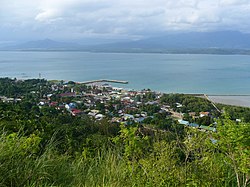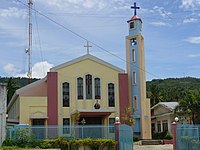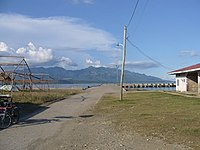Calubian
Calubian | |
|---|---|
| Municipality of Calubian | |
 Hilltop view of Calubian | |
 Map of Leyte with Calubian highlighted | |
 Calubian Location within the Philippines | |
| Coordinates: 11°27′N 124°25′E / 11.45°N 124.42°ECoordinates: 11°27′N 124°25′E / 11.45°N 124.42°E | |
| Country | Philippines |
| Region | Eastern Visayas |
| Province | Leyte |
| District | 3rd district |
| Barangays | 53 (see Barangays) |
| Government | |
| • Type | Sangguniang Bayan |
| • Mayor | Marciano A. Batiancela Jr. |
| • Vice Mayor | Gilbert S. Ponce |
| • Representative | Vicente Sofronio E. Veloso III |
| • Councilors | List |
| • Electorate | 23,596 voters (2019) |
| Area | |
| • Total | 100.95 km2 (38.98 sq mi) |
| Elevation | 82 m (269 ft) |
| Highest elevation | 1,336 m (4,383 ft) |
| Lowest elevation | 0 m (0 ft) |
| Population (2020 census) [3] | |
| • Total | 31,646 |
| • Density | 310/km2 (810/sq mi) |
| • Households | 7,796 |
| Economy | |
| • Income class | 4th municipal income class |
| • Poverty incidence | 40.48% (2015)[4] |
| • Revenue | ₱179,857,676.98 (2020) |
| • Assets | ₱267,834,642.97 (2020) |
| • Expenditure | ₱145,179,940.92 (2020) |
| • Liabilities | ₱127,886,533.47 (2020) |
| Service provider | |
| • Electricity | Leyte 5 Electric Cooperative (LEYECO 5) |
| Time zone | UTC+8 (PST) |
| ZIP code | 6534 |
| PSGC | |
| IDD : area code | +63 (0)53 |
| Native languages | Cebuano Tagalog |
Calubian, officially the Municipality of Calubian (Cebuano: Lungsod sa Calubian; Waray: Bungto han Calubian; Tagalog: Bayan ng Calubian), is a 4th class municipality in the province of Leyte, Philippines. According to the 2020 census, it has a population of 31,646 people. [3]
Barangays[]
Calubian is politically subdivided into 53 barangays.
- Abanilla
- Anislagan
- Bunacan
- Cabalquinto
- Herrera (Cabalhin)
- Cabradilla
- Caneja
- Cantonghao
- Caroyocan
- Casiongan
- Cristina
- Dalumpines
- Don Luis
- Dulao
- Efe (Ul-og)
- Enage
- Espinosa
- Ferdinand E. Marcos
- Garganera
- Garrido
- Guadalupe
- Gutosan
- Igang
- Inalad
- Jubay
- Juson
- Kawayan Bogtong
- Kawayanan
- Kokoy Romualdez
- Labtic
- Laray
- Limite (Agas)
- Manuel Veloso
- Mahait
- Malobago
- Matagok
- Nierras
- Nipa
- Obispo
- Pagatpat
- Pangpang
- Patag
- Pates
- Pal-og
- Padoga
- Petrolio
- Poblacion
- Railes
- Tabla
- Tagharigue
- Tuburan
- Villahermosa
- Villalon
- Villanueva
Climate[]
| Climate data for Calubian, Leyte | |||||||||||||
|---|---|---|---|---|---|---|---|---|---|---|---|---|---|
| Month | Jan | Feb | Mar | Apr | May | Jun | Jul | Aug | Sep | Oct | Nov | Dec | Year |
| Average high °C (°F) | 28 (82) |
29 (84) |
29 (84) |
31 (88) |
31 (88) |
30 (86) |
30 (86) |
30 (86) |
30 (86) |
29 (84) |
29 (84) |
29 (84) |
30 (85) |
| Average low °C (°F) | 22 (72) |
22 (72) |
22 (72) |
23 (73) |
24 (75) |
25 (77) |
25 (77) |
25 (77) |
25 (77) |
24 (75) |
24 (75) |
25 (77) |
24 (75) |
| Average precipitation mm (inches) | 73 (2.9) |
56 (2.2) |
75 (3.0) |
71 (2.8) |
114 (4.5) |
174 (6.9) |
172 (6.8) |
163 (6.4) |
167 (6.6) |
161 (6.3) |
158 (6.2) |
125 (4.9) |
1,509 (59.5) |
| Average rainy days | 15.2 | 12.5 | 16.2 | 17.3 | 23.9 | 27.3 | 28.4 | 26.9 | 26.9 | 27.1 | 23.8 | 19.3 | 264.8 |
| Source: Meteoblue (Use with caution: this is modeled/calculated data, not measured locally.) [5] | |||||||||||||
Demographics[]
|
| |||||||||||||||||||||||||||||||||||||||||||||
| Source: Philippine Statistics Authority [6] [7] [8][9] | ||||||||||||||||||||||||||||||||||||||||||||||
In the 2020 census, the population of Calubian, Leyte, was 31,646 people, [3] with a density of 310 inhabitants per square kilometre or 800 inhabitants per square mile.
Economy[]
| Poverty Incidence of Calubian | |
| Source: Philippine Statistics Authority[10][11][12][13][14][15] | |
History[]
On January 8, 1919, Governor Charles E. Yeater issued Executive Order No. 4, creating the town of Calubian which is formerly a barrio of the Municipality of Leyte, Leyte. Originally, its name was Eulalia in honor of a prominent lady resident. Later it was changed to Calubian due to the vast coconut plantation of the place (Photo shown is the Eulalia Monument located at the foot of the Veloso hill on the way to the Municipal Hall).
The Local Government of Calubian was formerly organized on January 22, 1919, with Felix Garganera as its first town executive. In 1922, he was succeeded by Nepumoceno Torlao, a generous resident of the locality. Then Alejandro Baronda took the reign as Local Chief Executive from 1931 to 1934. From 1934 to 1937, Felix Lafuente became the Town Chief followed by Francisco Enage in 1938 to 1940 and later on Enrique Q. Enage led the town from 1941 to 1942. They were followed by Lorenzo Mendoza from 1942 to 1944. Honorato Agas Sr led his people from 1945 to April 15, 1986, except for one term 1952-1953 when he was defeated by Rosendo Eamiguel, a popular landlord of Barangay Villalon.
The popular EDSA Revolution on February 25, 1986, brought an end to Agas’ term and Victorio Loygos Sr was eventually appointed as the OIC Mayor from April 16, 1986, to May 1987. Engr. Rolando R. Amparado succeeded him by appointment from June 24, 1987, to November 30, 1987, followed by Marciano Batiancela Jr from December 1, 1987, until the newly elected Local Chief Executive in the person of Dr. Carlos C. Cotiangco Jr. assumed office on February 8, 1988. He has done tremendous accomplishment in the Metro-Calubian by accomplishing several infrastructure projects such as concreting of municipal and barangay roads, public markets, waiting sheds, completion of municipal hall, improvement of the drainage system, multi-purpose pavements and water works projects.[16]
Gallery[]
|
References[]
- ^ Municipality of Calubian | (DILG)
- ^ "2015 Census of Population, Report No. 3 – Population, Land Area, and Population Density" (PDF). Philippine Statistics Authority. Quezon City, Philippines. August 2016. ISSN 0117-1453. Archived (PDF) from the original on May 25, 2021. Retrieved July 16, 2021.
- ^ a b c Census of Population (2020). "Region VIII (Eastern Visayas)". Total Population by Province, City, Municipality and Barangay. PSA. Retrieved 8 July 2021.
- ^ https://psa.gov.ph/sites/default/files/City%20and%20Municipal-level%20Small%20Area%20Poverty%20Estimates_%202009%2C%202012%20and%202015_0.xlsx; publication date: 10 July 2019; publisher: Philippine Statistics Authority.
- ^ "Calubian: Average Temperatures and Rainfall". Meteoblue. Retrieved 9 February 2020.
- ^ Census of Population (2015). "Region VIII (Eastern Visayas)". Total Population by Province, City, Municipality and Barangay. PSA. Retrieved 20 June 2016.
- ^ Census of Population and Housing (2010). "Region VIII (Eastern Visayas)". Total Population by Province, City, Municipality and Barangay. NSO. Retrieved 29 June 2016.
- ^ Censuses of Population (1903–2007). "Region VIII (Eastern Visayas)". Table 1. Population Enumerated in Various Censuses by Province/Highly Urbanized City: 1903 to 2007. NSO.
- ^ "Province of Leyte". Municipality Population Data. Local Water Utilities Administration Research Division. Retrieved 17 December 2016.
- ^ "Poverty incidence (PI):". Philippine Statistics Authority. Retrieved 28 December 2020.
- ^ https://psa.gov.ph/sites/default/files/NSCB_LocalPovertyPhilippines_0.pdf; publication date: 29 November 2005; publisher: Philippine Statistics Authority.
- ^ https://psa.gov.ph/sites/default/files/2003%20SAE%20of%20poverty%20%28Full%20Report%29_1.pdf; publication date: 23 March 2009; publisher: Philippine Statistics Authority.
- ^ https://psa.gov.ph/sites/default/files/2006%20and%202009%20City%20and%20Municipal%20Level%20Poverty%20Estimates_0_1.pdf; publication date: 3 August 2012; publisher: Philippine Statistics Authority.
- ^ https://psa.gov.ph/sites/default/files/2012%20Municipal%20and%20City%20Level%20Poverty%20Estima7tes%20Publication%20%281%29.pdf; publication date: 31 May 2016; publisher: Philippine Statistics Authority.
- ^ https://psa.gov.ph/sites/default/files/City%20and%20Municipal-level%20Small%20Area%20Poverty%20Estimates_%202009%2C%202012%20and%202015_0.xlsx; publication date: 10 July 2019; publisher: Philippine Statistics Authority.
- ^ "BRIEF HISTORY OF CALUBIAN". calubiansite.blogspot.com. Retrieved January 15, 2019.
External links[]
| Wikimedia Commons has media related to Calubian. |
- Municipalities of Leyte (province)







